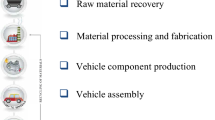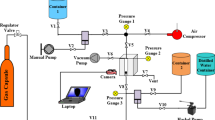Abstract
We are still largely dependent on SI and CI engines to power marine freight, aircraft and land transport. These engines make use of fossil fuels which are not just going to get depleted in due course; they are also a major cause of air pollution. Burning fossil fuels causes large emission of heat trapping gases which are responsible for the climatic changes being witnessed on our planet. There is an immediate need therefore to shift to alternate fuels which are greener and sustainable. Six different fuel blends were used for this study which was prepared by mixing different proportions of ethanol, methanol, butanol and gasoline. The purpose of mixing alcohols with gasoline is to reduce to consumption of gasoline. These blends have reported satisfactory engine performance and also burn greener. Alcohols have numerous advantages as fuels but they are polar and have high affinity towards moisture. This makes these alcohol–gasoline blends to be more corrosive in nature. The present study measures the corrosion rate of aluminium and mild steel (MS) using potentiodynamic polarization and impedance spectroscopy. Electrochemical studies were performed using a three-electrode system. These techniques are much more rapid when compared to the traditional weight loss measurement techniques. Tafel plots directly give the corrosion current and corrosion rate. Electrochemical impedance spectroscopy is also a reliable technique to determine corrosion rate and can accurately measure extremely small corrosion rate values even in a low-conducting alcohol–gasoline fuel blend environment. Of the two metals studied, MS was found to be prone to undergoing more corrosion. The results would be of great help to assess the compatibility of the metallic parts of the automobiles and of fuelling infrastructure materials with these alternate fuels.










Similar content being viewed by others
References
Baena LM, Vásquez FA, Calderón JA (2021) Corrosion assessment of metals in bioethanol–gasoline blends using electrochemical impedance spectroscopy. Heliyon 7(7):e07585
Banaś J, Stypuła B, Banaś K, Światowska-Mrowiecka J, Starowicz M, Lelek-Borkowska U (2009) Corrosion and passivity of metals in methanol solutions of electrolytes. J Solid State Electrochem 13:1669–1679
Baros P, Matejovsky L, Macak J, Stas M, Pospisil M (2022) Corrosion Aggressiveness of ethanol–gasoline and butanol–gasoline blends on steel: application of electrochemical impedance spectroscopy. Energy Fuels 36:2616–2629
Brito-Franco A, Uruchurtu J, Rosales-Cadena I, Lopez-Sesenes R, Serna-Barquera SA, Hernandez-Perez JA, Rocabruno-Valdes C, Gonzalez-Rodriguez JG (2020) Corrosion behavior of Al in ethanol–gasoline blends. Energies 13(21):5544
Cheng S, Chen S, Liu T, Chang X, Yin Y (2007) Carboxymethylchitosan+ Cu2+ mixture as an inhibitor used for mild steel in 1 M HCl. Electrochim Acta 52(19):5932–5938
Elfasakhany A (2017) Investigations on performance and pollutant emissions of spark-ignition engines fueled with n-butanol, isobutanol, ethanol, methanol, and acetone gasoline blends: a comparative study. Renew Sustain Energy Rev 71:404–413
Feliu S Jr (2020) Electrochemical impedance spectroscopy for the measurement of the corrosion rate of magnesium alloys: Brief review and challenges. Metals 10(6):775
Jafari H, Idris MH, Ourdjini A, Rahimi H, Ghobadian B (2011) EIS study of corrosion behavior of metallic materials in ethanol blended gasoline containing water as a contaminant. Fuel 90:1181–1187
Jamali SS, Moulton SE, Tallman DE, Forsyth M, Wallace GG (2015) Evaluating the corrosion behaviour of Magnesium alloy in simulated biological fluid by using SECM to detect hydrogen evolution. Electrochim Acta 152:294–301
Jiangfang Z, Xuehong C (2019) Compatibility study of high-density polyethylene with ethanol–gasoline and biodiesel. J Elastom Plast 53(1):3–13
Kass M, Janke C, Connatser M, West B (2020) Solubility and volume swell of fuel system elastomers with ketone blends of E10 gasoline and blendstock for oxygenate blending (BOB). J Elastom Plast 52(7):645–663
Kass MD, Theiss TJ, Janke CJ, Pawel SJ (2012) Compatibility study for plastic, elastomeric, and metallic fueling infrastructure materials exposed to aggressive formulations of ethanol-blended gasoline. ORNL/TM2012/88.
Larabi L, Harek Y, Traisnel M, Mansri A (2004) Synergistic influence of poly (4-vinylpyridine) and potassium iodide on inhibition of corrosion of mild steel in 1M HCl. J Appl Electrochem 34:833–839
Li Y, Gong J, Deng Y, Yuan W, Fu J, Zhang B (2017) Experimental comparative study on combustion, performance and emissions characteristics of methanol, ethanol and butanol in a spark ignition engine. Appl Therm Eng 115:53–63
Lorenz WJ, Mansfield F (1981) Determination of corrosion rates by electrochemical DC and AC methods. Corros Sci 21:647–672
Matějovský L, Macák J, Pospíšil M, Baroš P, Staš M, Krausová A (2017) Study of corrosion of metallic materials in ethanol–gasoline blends: application of electrochemical methods. Energy Fuels 31(10):10880–10889
Matějovský L, Macák J, Pleyer O, Straka P, Staš M (2019) Efficiency of steel corrosion inhibitors in an environment of ethanol–gasoline blends. ACS Omega 4(5):8650–8660
Matějovský L, Baros P, Staš M, Pospíšil M, Macák J (2021) Electrochemical study of mild steel resistance in butanol-gasoline and ethanol–gasoline blends. Energy Fuels 35:19507–19524
Nair P, Nandakrishnan MH (2021) Review on the synthesis, performance and trends of butanol: a cleaner fuel additive for gasoline. Int J Ambient Energy 43(1):4207–4223. https://doi.org/10.1080/01430750.2021.1873849
Nandakrishnan MH, Nair P, Balakrishna S (2021) Metals and fuel system polymers on exposure to Dimethyl Ether: A material compatibility study. Eng Fail Anal 129:105668. https://doi.org/10.1016/j.engfailanal.2021.105668
Shirazi SA, Abdollahipoor B, Windom B, Reardon KF, Foust TD (2020) Effects of blending C3–C4 alcohols on motor gasoline properties and performance of spark ignition engines: a review. Fuel Process Technol 197:106194. https://doi.org/10.1016/j.fuproc.2019.106194
Yadav M, Kumar S, Purkait T, Olasunkanmi LO, Bahadur I, Ebensi EE (2016) Electrochemical, thermodynamic and quantum chemical studies of synthesized benzimidazole derivatives as corrosion inhibitors for N80 steel in hydrochloric acid. J Mol Liq 213:122–138. https://doi.org/10.1016/j.molliq.2015.11.018
Yusri IM, Mamat R, Azmi WH, Najafi G, Sidik NAC, Awad OI (2016) Experimental investigation of combustion, emissions and thermal balance of secondary butyl alcohol–gasoline blends in a spark ignition engine. Energy Convers Manag 123:1–14
Author information
Authors and Affiliations
Corresponding author
Additional information
Publisher's Note
Springer Nature remains neutral with regard to jurisdictional claims in published maps and institutional affiliations.
Supplementary Information
Below is the link to the electronic supplementary material.
Rights and permissions
Springer Nature or its licensor (e.g. a society or other partner) holds exclusive rights to this article under a publishing agreement with the author(s) or other rightsholder(s); author self-archiving of the accepted manuscript version of this article is solely governed by the terms of such publishing agreement and applicable law.
About this article
Cite this article
Nair, P., Nandakrishnan, M.H. & Dhanavel, N. Electrochemical studies on the corrosion performance of ternary ethanol–butanol–gasoline and methanol–butanol–gasoline blends. Chem. Pap. 78, 1517–1527 (2024). https://doi.org/10.1007/s11696-023-03178-4
Received:
Accepted:
Published:
Issue Date:
DOI: https://doi.org/10.1007/s11696-023-03178-4




